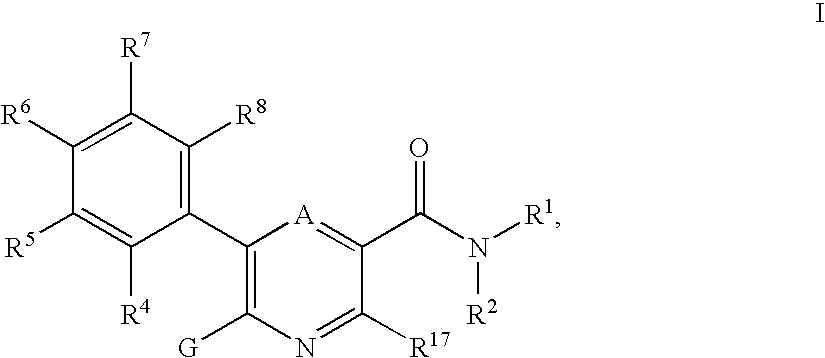3-pyridinecarboxamide derivatives as HDL-cholesterol raising agents
a technology of hdl-cholesterol and derivatives, which is applied in the direction of biocide, drug composition, metabolic disorders, etc., can solve the problems of not being able to achieve wholly satisfactory hdl-elevating therapies, reducing compliance, and significantly elevating plasma hdl levels, so as to achieve the effect of potent hdl-cholesterol raising agents and treatment and/or prophylaxis of diseases
- Summary
- Abstract
- Description
- Claims
- Application Information
AI Technical Summary
Benefits of technology
Problems solved by technology
Method used
Image
Examples
example 1
Effects on Plasma Lipid Levels in Lean, Chow Fed Rats
[0562]Effects of compounds of formula I on plasma lipid levels were determined in lean, chow-fed male Sprague-Dawley rats with compounds administered by p.o. gavage. After one week of acclimation, blood samples were collected from 4 hour-fasted animals for plasma lipid determination. Animals were then assigned to treatment groups based on HDL-cholesterol levels. Compounds of formula I were administered by gavage, once daily for five days. Control animals received vehicle alone. Blood was collected on day five from 4 hour-fasted rats, 2 hours after a final treatment, for plasma lipid analysis. Total cholesterol, HDL-cholesterol, and triglycerides were determined by measuring total cholesterol, HDL-cholesterol, and triglyceride using calorimetric enzymatic assays (Roche Diagnostic GmbH, Mannheim, Germany). HDL-C was also quantified using size exclusion chromatography on superpose-6 column using a SMART system (Pharmacia). Lipoprotei...
example 2
Effects on Plasma Lipid Levels in Obese, High Fat Diet Fed Rats
[0564]Efficacy of compounds in modulating plasma lipid levels was determined also in obese male Sprague Dawley rats after 28-29 days administration of compounds. Male Sprague-Dawley rats of 10 weeks of age were fed a high fat diet during 3 weeks. Obese rats were distributed in groups according to homogeneous BW and FI evaluated a week before the start of the treatment. Treatment was administered as food-Admix. On day 29, blood was taken in the morning under slight anesthesia (retro-orbital method) in post-prandial conditions i.e. 4 h after food was removed. Plasma was separated from blood by low speed centrifugation and selected organs were taken (e.g. liver, fat). Total cholesterol, HDL-cholesterol, and triglycerides were determined by measuring total cholesterol, HDL-cholesterol and triglyceride using calorimetric enzymatic assays (Roche Diagnostic GmbH, Mannheim, Germany). HDL-C was also quantified using size exclusio...
example 3
Effects on Plasma Lipid Levels in Hamsters
[0566]Efficacy of compounds in modulating plasma lipid levels was determined in hamsters after 5 days of daily administration of compounds. Male hamsters of 6-8 weeks of age were used in the studies. After one week of acclimation, blood samples were collected from 4 hour-fasted animals for plasma lipid determination. Animals were then assigned to treatment groups based on HDL-cholesterol levels. Compounds were administered by gavage, once daily for five days. Control animals received vehicle alone. Blood was collected on day five from 4 hour-fasted hamsters, 2 hours after a final treatment, for plasma lipid analysis. Total cholesterol, HDL-cholesterol, LDL-cholesterol, and triglycerides were determined using calorimetric enzymatic assays (Roche Diagnostic GmbH, Mannheim, Germany). HDL-cholesterol, LDL-cholesterol, and VLDL-cholesterol levels were also quantified using size exclusion chromatography on superpose-6 column using a SMART system (...
PUM
 Login to View More
Login to View More Abstract
Description
Claims
Application Information
 Login to View More
Login to View More - R&D
- Intellectual Property
- Life Sciences
- Materials
- Tech Scout
- Unparalleled Data Quality
- Higher Quality Content
- 60% Fewer Hallucinations
Browse by: Latest US Patents, China's latest patents, Technical Efficacy Thesaurus, Application Domain, Technology Topic, Popular Technical Reports.
© 2025 PatSnap. All rights reserved.Legal|Privacy policy|Modern Slavery Act Transparency Statement|Sitemap|About US| Contact US: help@patsnap.com



